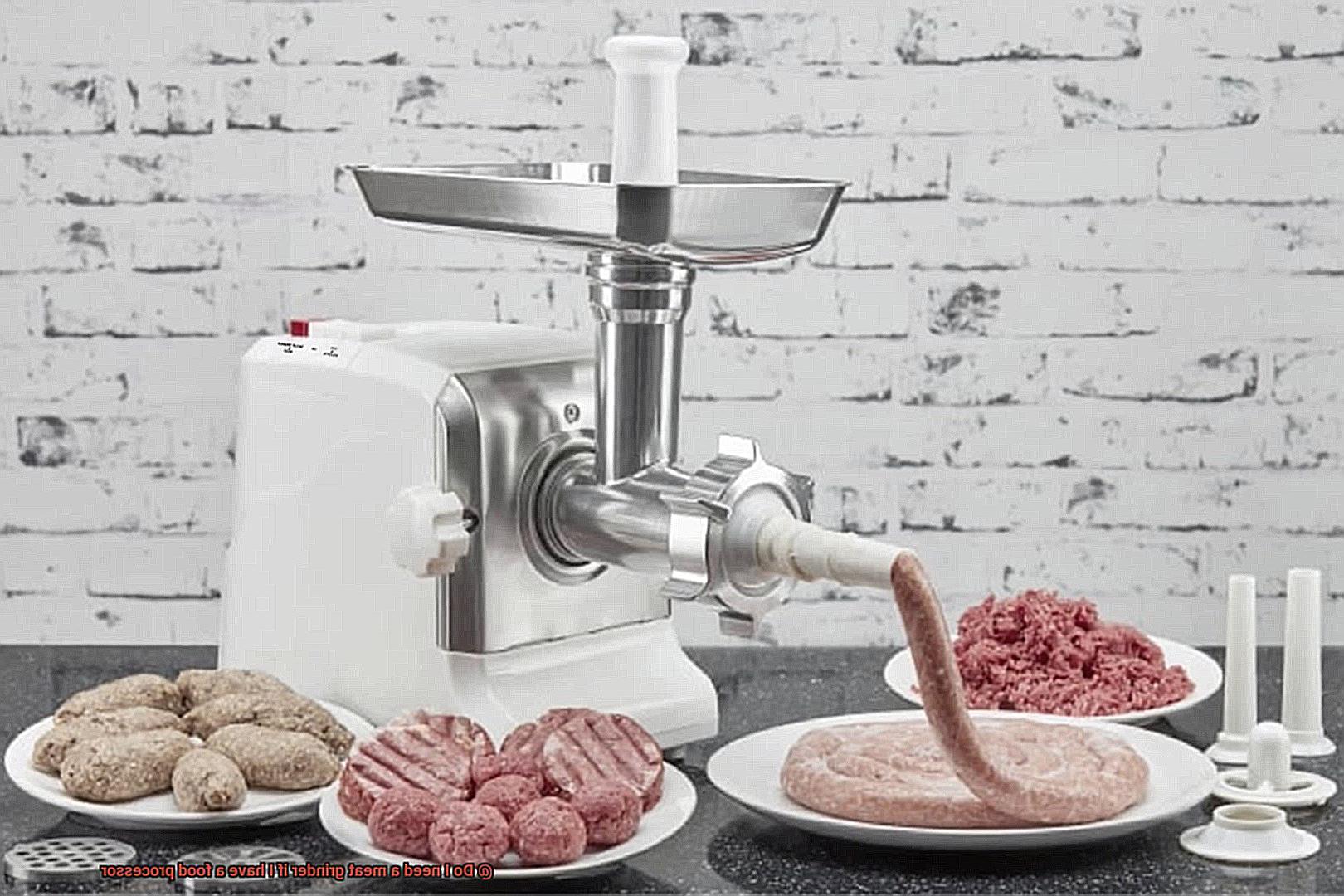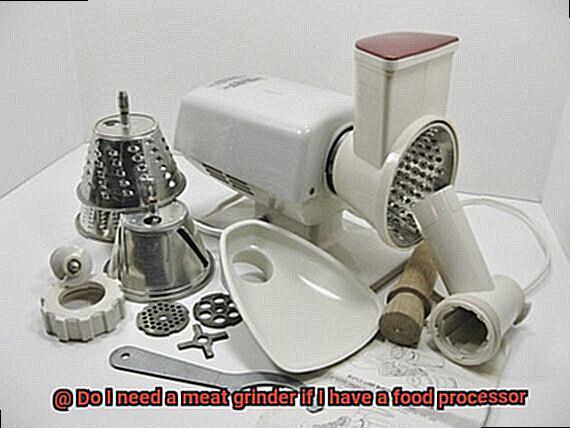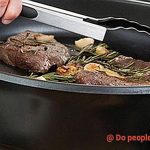Are you fed up with buying ground meat from the grocery store that’s sometimes contaminated and lacks the freshness you crave? Do you own a food processor and ponder if it can replace a meat grinder? You’re not alone; many home cooks share this same query. Fear not, for we are here to delve into the question, ‘Do I need a meat grinder if I have a food processor?’ and provide an all-encompassing answer.
A food processor is a versatile kitchen appliance that can perform various tasks, such as shredding cheese, kneading dough, and even grinding meat. However, when it comes to grinding meat, a food processor may not be your best bet. Meat grinders are specifically designed to grind different types of meat to your desired consistency, whether coarse or fine. This makes them the ideal tool for creating sausages, burgers, meatballs, and much more.
In this blog post, we’ll compare a food processor with a meat grinder and explore their distinctions in functionality and effectiveness. We’ll also discuss which one is better suited for grinding specific types of meat and what factors to consider when choosing between a food processor and a meat grinder. So if you’re eager to learn more about this topic and take your culinary skills up a notch, then keep reading.
Contents
What is a Meat Grinder and How Does It Work?
A meat grinder is designed to grind meat and other ingredients with ease.
Meat grinders come in different sizes and types, including manual and electric. Manual meat grinders may require more physical effort, but they are less expensive and easier to clean. On the other hand, electric meat grinders are more convenient since they require less effort, but can be more expensive and harder to clean.
To use a meat grinder, first, cut your meat into smaller pieces that will fit into the hopper. Attach the blade or plate that will grind the meat, turn on the grinder, and start feeding the meat into the hopper. Depending on your grinder’s type, you may need to stop periodically to clear out any clogs or excess fat.

One significant advantage of using a meat grinder over a food processor is that you have more control over the texture of your ground meat. Meat grinders typically come with different-sized plates that allow you to choose the coarseness of your grind, while food processors only have one blade that may result in a more uniform texture.
Meat grinders are also versatile; you can use them to grind different types of meat, including beef, pork, chicken, turkey, and game meats like venison. Moreover, you can make sausages, burgers, and other types of ground meat dishes with a meat grinder.
It is worth noting that tougher cuts of meat require more power to grind than leaner cuts like chicken breasts or turkey. While some food processors may be able to handle tougher cuts of meat, they may not be as efficient or effective as a dedicated meat grinder. If you plan on grinding tougher cuts of meat frequently, investing in a meat grinder may be worth it in the long run.
What is a Food Processor and How Does It Work?
A food processor is a must-have kitchen appliance that can handle a wide range of tasks. It can chop, slice, shred, puree, and mix just about anything you throw at it. The motorized base unit contains a powerful motor and interchangeable blades and disks that make switching between tasks a breeze.
Using a food processor is incredibly simple. All you need to do is select the appropriate blade or disk for your desired task and add the food items to the processing bowl. Turn the machine on and let it do its job, leaving you with perfectly chopped vegetables or creamy hummus in no time.
But what makes a food processor so useful? It’s especially handy when it comes to making salsa, hummus, or pesto, where you need to combine multiple ingredients into a smooth paste or sauce. It also excels at cutting vegetables into small and consistent pieces for stir-fries or salads.
However, if you’re planning on grinding your own meat regularly or require a finer level of consistency than a food processor can provide, it might be worth investing in a dedicated meat grinder. While some food processors do come with grinding attachments, they might not be able to produce the same level of consistency and texture as a dedicated meat grinder. Additionally, the high-speed spinning blades of a food processor can heat up the meat, affecting its texture and flavor.
Advantages of Using a Meat Grinder Over a Food Processor
Maybe you want to take your homemade sausages or burgers to the next level. Look no further than a dedicated meat grinder, which offers several advantages over a food processor.
Firstly, meat grinders are designed specifically for grinding meat. With different-sized blades and plates, you have more control over the texture of your ground meat. Whether you want a fine grind for your sausages or a coarse grind for your burgers, a meat grinder delivers consistent results that a food processor just can’t match.
Secondly, meat grinders are more powerful than food processors. They can handle tougher cuts of meat without getting bogged down, resulting in evenly ground meat every time. Say goodbye to frustration and uneven results when trying to grind tough pieces of meat with a food processor.
Thirdly, cleaning a meat grinder is a breeze compared to a food processor. With fewer parts and easy disassembly, you can clean your meat grinder thoroughly without any hassle. This is especially important when grinding fatty meats that can leave residue in hard-to-reach places in a food processor.
Finally, if you’re planning on making sausages or burgers, a meat grinder is a must-have tool. Meat grinders come with sausage stuffing attachments that make it easy to stuff casings with your favorite meats. You can also mix in spices and seasonings for more flavorful burgers or sausages.
Factors to Consider When Deciding Between a Meat Grinder or Food Processor
Firstly, think about the kind of meat you want to grind. If it’s tougher cuts like beef or pork, then a meat grinder is undoubtedly the better choice. Meat grinders can handle these cuts with ease and precision, producing a desirable texture. In contrast, food processors may struggle to grind them, leading to an unappetizing result.
Next, consider the quantity of meat you plan on grinding. If you’re looking to grind large volumes of meat regularly, then a meat grinder is your best bet. Meat grinders are designed to handle larger volumes of meat and prevent overheating, which can be a problem when using a food processor.
Texture is also an essential factor to consider. If you want more control over the texture of your ground meat, then a meat grinder is ideal as it offers various grind settings. On the other hand, food processors tend to produce finer grinds, which may not be suitable for some dishes.
If versatility is what you’re after, then a food processor is the winner. It can be used for multiple tasks such as chopping vegetables, making dough, and pureeing fruits. However, if you plan on using the appliance solely for grinding meat, then a meat grinder might be the better option.
Lastly, budget is an important factor that cannot be ignored. Meat grinders are typically more expensive than food processors. So before making any decisions, it’s essential to determine your budget and stick to it.
Types of Meat Suitable for Use in Each Appliance
Grinding meat is a versatile task that requires the right appliance for each job. When it comes to selecting the right appliance, it’s essential to consider the type and texture of meat being used.
Meat grinders are perfect for tougher cuts of meat like beef, pork, and venison. These meats have connective tissues that need to be broken down during the grinding process, and meat grinders are designed to do just that. The sharp blades in a meat grinder can handle these tougher meats, leaving you with a finer texture that’s perfect for burgers, sausages, and meatballs. Additionally, meat grinders allow for greater control over the texture and consistency of the ground meat, which is essential for recipes that require specific textures.
Food processors are better suited for softer meats like chicken and turkey. These meats are already tender and don’t require as much force to break down, making them ideal for use in a food processor. However, it’s important to note that food processors may not produce ground meat that is as uniform as that produced by a meat grinder. The blades in a food processor may also heat up during the grinding process, which can affect the texture and flavor of the ground meat.
When selecting the type of meat to use with each appliance, it’s also important to consider the fat content of the meat. Meat grinders work best with meats with higher fat content as this results in a juicier and more flavorful end product. On the other hand, food processors are better suited for leaner cuts of meat, as they don’t have the same capabilities as a meat grinder in terms of handling fat.
Another essential consideration when using a food processor to grind meat is pulsing. Pulsing the machine in short bursts rather than continuously running it will prevent the meat from becoming too fine and turning into a paste-like consistency.
Pros and Cons of Using a Meat Grinder vs. Food Processor
Let’s delve into the pros and cons of using a meat grinder versus a food processor to help you make an informed decision.
Meat Grinder Pros
- Consistency: A meat grinder is designed specifically for grinding meat and produces uniform results every time.
- Adjustable grind: You can adjust the blades to create different grind sizes, from fine mince to coarse ground beef.
- Texture and flavor: Ground meat from a meat grinder tends to have better texture and flavor compared to that from a food processor.
Meat Grinder Cons
- Limited use: A meat grinder is designed only for grinding meat and cannot be used for other tasks.
- Cleaning: A meat grinder requires disassembly and cleaning of various parts, which may be time-consuming.
Food Processor Pros
- Versatility: A food processor can be used for various tasks besides grinding meat, such as chopping vegetables or making sauces.
- Ease of use: Simply throw in the chunks of meat and let the blades do the work.
- Easy to clean: Some models may have dishwasher-safe parts that make cleaning a breeze.
Food Processor Cons
- Inconsistent results: A food processor may not produce as uniform results as a meat grinder, resulting in some pieces being larger than others.
- Paste-like consistency: Ground meat from a food processor tends to have a more paste-like consistency, which may affect the texture and flavor of dishes made with ground meat.
When choosing between a meat grinder and a food processor, consider factors such as your personal preferences, frequency of use, and desired outcomes. If you want consistent results every time and plan on grinding meat frequently, a meat grinder may be the better option. On the other hand, if you want an appliance that can handle other tasks besides grinding meat and only need to grind meat occasionally, a food processor may be more suitable.
Tips for Successfully Grinding Meat in a Food Processor
Grinding meat at home using a food processor can be a convenient and cost-effective way to achieve customized ground meats for your favorite recipes. However, not all food processors are created equal when it comes to grinding meat, and there are some important tips to keep in mind for successful results.
Tip #1: Use the right type of meat.
Choosing cuts of meat with a higher fat content such as chuck or sirloin will produce juicier and more flavorful ground meat. Leaner cuts like round or flank steak may result in dry and tough ground meat.
Tip #2: Keep the meat cold.
It is crucial to keep the meat as cold as possible before grinding it in the food processor. Placing it in the freezer for around 20-30 minutes will prevent the fat from melting and ensure even grinding.
Tip #3: Cut the meat into small pieces.
Cutting the meat into small, uniform chunks that will fit easily into the food processor’s feed tube will make the grinding process easier and prevent clogging.
Tip #4: Use short pulses.
When grinding meat in a food processor, using short pulses rather than continuous grinding allows for more control over the texture and prevents overworking the meat, resulting in a tough texture.
Tip #5: Clean thoroughly after use.
Meat can leave behind bacteria that can be harmful if not properly cleaned. Disassemble all parts of the food processor and wash them thoroughly with hot, soapy water or put them in the dishwasher.
NfKhLrZqt5c” >
Conclusion
To sum up, the question of whether a food processor can replace a meat grinder has been thoroughly examined. While a food processor can grind meat, it may not deliver consistent results and texture control. Meat grinders, on the other hand, are purpose-built to grind various types of meat and provide greater control over consistency and texture. They are also more powerful and easier to clean than food processors.
When deciding between a meat grinder or food processor, several factors should be taken into account such as the type of meat being used, desired outcomes, frequency of use, and budget. If grinding tougher cuts of meat regularly or seeking more control over texture and consistency, investing in a dedicated meat grinder may be worthwhile. However, if versatility is crucial or only occasionally grinding meat is required, then a food processor may suffice.
If using a food processor to grind meat successfully, remember to use the right kind of meat with higher fat content, keep the meat chilled before grinding, cut it into small pieces, use short pulses rather than continuous grinding and clean thoroughly after use.






